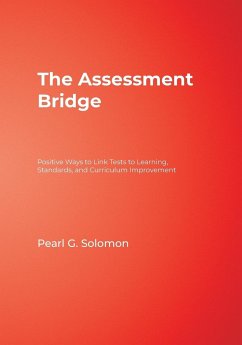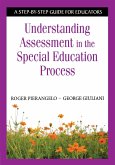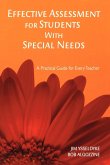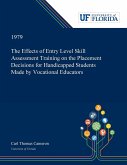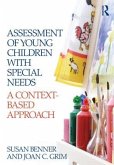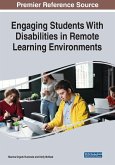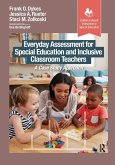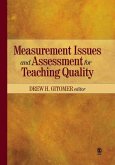Pearl G. Solomon
The Assessment Bridge
Positive Ways to Link Tests to Learning, Standards, and Curriculum Improvement
Pearl G. Solomon
The Assessment Bridge
Positive Ways to Link Tests to Learning, Standards, and Curriculum Improvement
- Broschiertes Buch
- Merkliste
- Auf die Merkliste
- Bewerten Bewerten
- Teilen
- Produkt teilen
- Produkterinnerung
- Produkterinnerung
Award-winning educator Pearl Solomon presents a clear-headed and cogent analysis of today's high-stakes standards-based testing movement.
Andere Kunden interessierten sich auch für
![Understanding Assessment in the Special Education Process Understanding Assessment in the Special Education Process]() Roger PierangeloUnderstanding Assessment in the Special Education Process32,99 €
Roger PierangeloUnderstanding Assessment in the Special Education Process32,99 €![Effective Assessment for Students with Special Needs Effective Assessment for Students with Special Needs]() James E. YsseldykeEffective Assessment for Students with Special Needs28,99 €
James E. YsseldykeEffective Assessment for Students with Special Needs28,99 €![The Effects of Entry Level Skill Assessment Training on the Placement Decisions for Handicapped Students Made by Vocational Educators The Effects of Entry Level Skill Assessment Training on the Placement Decisions for Handicapped Students Made by Vocational Educators]() Carl CameronThe Effects of Entry Level Skill Assessment Training on the Placement Decisions for Handicapped Students Made by Vocational Educators74,99 €
Carl CameronThe Effects of Entry Level Skill Assessment Training on the Placement Decisions for Handicapped Students Made by Vocational Educators74,99 €![Assessment of Young Children with Special Needs Assessment of Young Children with Special Needs]() Susan M. BennerAssessment of Young Children with Special Needs83,99 €
Susan M. BennerAssessment of Young Children with Special Needs83,99 €![Engaging Students With Disabilities in Remote Learning Environments Engaging Students With Disabilities in Remote Learning Environments]() Engaging Students With Disabilities in Remote Learning Environments176,99 €
Engaging Students With Disabilities in Remote Learning Environments176,99 €![Everyday Assessment for Special Education and Inclusive Classroom Teachers Everyday Assessment for Special Education and Inclusive Classroom Teachers]() Frank DykesEveryday Assessment for Special Education and Inclusive Classroom Teachers81,99 €
Frank DykesEveryday Assessment for Special Education and Inclusive Classroom Teachers81,99 €![Measurement Issues and Assessment for Teaching Quality Measurement Issues and Assessment for Teaching Quality]() Drew H. GitomerMeasurement Issues and Assessment for Teaching Quality189,99 €
Drew H. GitomerMeasurement Issues and Assessment for Teaching Quality189,99 €-
-
-
Award-winning educator Pearl Solomon presents a clear-headed and cogent analysis of today's high-stakes standards-based testing movement.
Hinweis: Dieser Artikel kann nur an eine deutsche Lieferadresse ausgeliefert werden.
Hinweis: Dieser Artikel kann nur an eine deutsche Lieferadresse ausgeliefert werden.
Produktdetails
- Produktdetails
- Verlag: Corwin
- Seitenzahl: 192
- Erscheinungstermin: 14. Juni 2002
- Englisch
- Abmessung: 254mm x 178mm x 11mm
- Gewicht: 373g
- ISBN-13: 9780761945949
- ISBN-10: 0761945946
- Artikelnr.: 22264483
- Herstellerkennzeichnung
- Libri GmbH
- Europaallee 1
- 36244 Bad Hersfeld
- gpsr@libri.de
- Verlag: Corwin
- Seitenzahl: 192
- Erscheinungstermin: 14. Juni 2002
- Englisch
- Abmessung: 254mm x 178mm x 11mm
- Gewicht: 373g
- ISBN-13: 9780761945949
- ISBN-10: 0761945946
- Artikelnr.: 22264483
- Herstellerkennzeichnung
- Libri GmbH
- Europaallee 1
- 36244 Bad Hersfeld
- gpsr@libri.de
Pearl G. Solomon is professor emerita of teacher education at St. Thomas Aquinas College in Sparkill, New York. She has served as a director and officer for professional organizations and as a consultant to many school districts, the New York State Education Department, and the United States Department of Education. Solomon is the recipient of a number of special awards from the state and community for her work in science, math, health, and career education.
Foreword - by Ann Lieberman
Preface
About the Author
1. Defining the Problem: The Historical Context
About This Chapter
Schools as Transmitters of Culture
What Early 20th-Century Schools Were Like
My School in Bethel
Elementary Schools in Depression-Era New York City
Education Beyond the Classroom
Schools in the Later 20th Century: A Beginning Teacher
IQ Tests and Regents Exams
Defining and Dealing With Differences
What the Research Told Us
Proving My Point: Giving Students Choices
Back to Basics
Special Education
Using History as a Decision Base
2. Schools at the Beginning of the 21st Century: Problems and Proposed
Solutions
About This Chapter
Defining the Problem
Proposed Solution One: Defining Educational Standards
Proposed Solution Two: School Accountability
The Government Response: High-Stake Testing
High-Stakes Testing: The Other Stakeholders Respond
Proposed Solution Three: Achieveing Equity Through School Choice
Proposed Solution Four: Extending the Time for Schooling
Time for Enrichment
Time for a Good Start
Proposed Solution Five: Technology in the Classroom
The Research Base for Technology Use
Technology as an Assessment Tool and Manager
The Current Status of the Use of Technology in Schools
Technology for Communicating With Our Public
Some Conclusions About Technology in the Classroom
3. Taking the First Steps Toward Productive Change
About This Chapter
The Variables of Change
Vision and Voice
History and Setting
Bounded Rationality
Opportunism and Asset-Specific Investments
Step One: Building New Capacity
Step Two: Generating Ownership
Step Three: Assuming Leadership
Step Four: Providing Time for Learning and Change
Changing Schools in the Search for a Better Future
4. The Assessment Roadway: How Tests Tell Us What to Do
About This Chapter
Demonstrating Knowledge
Defining Standards and Assessment
Rubrics
The Task-Specific Rubric
The Developmental Rubric
Using Rubrics in Formative and Summative Assessment
Summative Applications
Generating Ownership of Tests
Reaching Consensus on Group Summative Scores
Matching Distal and Proximal Measures
Validity: Does It Fit?
Generating Ownership: Begin With Curriculum-Based Proximal Assessments
Preparing for the Tests: Curriculum Teaching
Proximal Measures Responding to HSSB Analyses
What Lies Beneath: Disaggregating Scores
Disaggregating for Noninstructional Differences
Relationship of Teacher Training and Experience to Student Achievement
Other Cultural and School Variables: Confronting the Achievement Gap
5. Responding to High-Stakes, Standards-Based (HSSB) Tests: Restructuring
Curriculum
About This Chapter
Two Alternative Responses to HSSB Tests
Alternative One: Starting With the HSSB Test
Embedded Concepts
Assessment-Responsive Curriculum Adjustments
Starting From a Core of HSSB Tests: Applying and Responding to Analysis
Alternative Two: Starting With the Standards
Responding to Test Data With Curriculum Reconstruction
In Conclusion: Assessing Oneself
6. Building a Cohort of the Best Teachers: Recruitment, Engagement,
Nurturance
About This Chapter
About Models
Why We Need to Recruit Teachers
Where Teachers Used to Come From
Why There Is a Current Shortage: The Recruitment Pool
Why There Is a Current Shortage: Retention
Solving the Prestige Problem: Interdependent Stakeholders
Solving the Prestige Problem: Changing the Agenda of Teacher Unions
Solving the Prestige Problem: Raising Teacher Salaries
The REN Model: Recruiting Heroes
The REN Model: Educating Recruits
The REN Model: Engagement in Action
The REN Model: Engagement in Interaction
The REN Model: Nurturing Novices
Nurturing Experienced Teachers: The Need for Better Professional
Development
Motivating Teachers to Participate in Professional Development
A Cooperative-Teaching Model
How I Learned: Cooperative Teaching
Professional-Development Schools: Object Linking and Embedding (OLE)
Relationships
An Example: The East Ramapo and St. Thomas Aquinas College PDS
Engaging in the OLE Process
Some General Conclusions About Increasing Teachers¿ Capacity
7. Searching for Leadership
About This Chapter
Understanding Leadership and Power
Direct and Indirect Messages
Evoking Change
Leading: Giving Power and Indirect Messages
How Educational Leaders Act
A Personal Analysis From the Distributive Perspective
Shared Leadership and Power
The Power of Money, Matches, Tradition, Time, and Place
Social Interactions, Macrotasks, and Microtasks in Curriculum Leadership
Roles
Social Interactions, Macrotasks, and Microtasks in the Principal Leadership
Role
The Shortage of Administrators
Leadership by Teachers
Leadership by Teacher Networks
MCMSC Network: Sample Activities
What We Learned About Leadership Needs
Addressing Sociocultural Needs: Other Sources and Focuses of Leadership
Community-Based Leadership: Project Excel
Community-Based Leadership: Windhover Farm
Using Models to Build the Assessment Bridge
Epilogue
References
Index
Preface
About the Author
1. Defining the Problem: The Historical Context
About This Chapter
Schools as Transmitters of Culture
What Early 20th-Century Schools Were Like
My School in Bethel
Elementary Schools in Depression-Era New York City
Education Beyond the Classroom
Schools in the Later 20th Century: A Beginning Teacher
IQ Tests and Regents Exams
Defining and Dealing With Differences
What the Research Told Us
Proving My Point: Giving Students Choices
Back to Basics
Special Education
Using History as a Decision Base
2. Schools at the Beginning of the 21st Century: Problems and Proposed
Solutions
About This Chapter
Defining the Problem
Proposed Solution One: Defining Educational Standards
Proposed Solution Two: School Accountability
The Government Response: High-Stake Testing
High-Stakes Testing: The Other Stakeholders Respond
Proposed Solution Three: Achieveing Equity Through School Choice
Proposed Solution Four: Extending the Time for Schooling
Time for Enrichment
Time for a Good Start
Proposed Solution Five: Technology in the Classroom
The Research Base for Technology Use
Technology as an Assessment Tool and Manager
The Current Status of the Use of Technology in Schools
Technology for Communicating With Our Public
Some Conclusions About Technology in the Classroom
3. Taking the First Steps Toward Productive Change
About This Chapter
The Variables of Change
Vision and Voice
History and Setting
Bounded Rationality
Opportunism and Asset-Specific Investments
Step One: Building New Capacity
Step Two: Generating Ownership
Step Three: Assuming Leadership
Step Four: Providing Time for Learning and Change
Changing Schools in the Search for a Better Future
4. The Assessment Roadway: How Tests Tell Us What to Do
About This Chapter
Demonstrating Knowledge
Defining Standards and Assessment
Rubrics
The Task-Specific Rubric
The Developmental Rubric
Using Rubrics in Formative and Summative Assessment
Summative Applications
Generating Ownership of Tests
Reaching Consensus on Group Summative Scores
Matching Distal and Proximal Measures
Validity: Does It Fit?
Generating Ownership: Begin With Curriculum-Based Proximal Assessments
Preparing for the Tests: Curriculum Teaching
Proximal Measures Responding to HSSB Analyses
What Lies Beneath: Disaggregating Scores
Disaggregating for Noninstructional Differences
Relationship of Teacher Training and Experience to Student Achievement
Other Cultural and School Variables: Confronting the Achievement Gap
5. Responding to High-Stakes, Standards-Based (HSSB) Tests: Restructuring
Curriculum
About This Chapter
Two Alternative Responses to HSSB Tests
Alternative One: Starting With the HSSB Test
Embedded Concepts
Assessment-Responsive Curriculum Adjustments
Starting From a Core of HSSB Tests: Applying and Responding to Analysis
Alternative Two: Starting With the Standards
Responding to Test Data With Curriculum Reconstruction
In Conclusion: Assessing Oneself
6. Building a Cohort of the Best Teachers: Recruitment, Engagement,
Nurturance
About This Chapter
About Models
Why We Need to Recruit Teachers
Where Teachers Used to Come From
Why There Is a Current Shortage: The Recruitment Pool
Why There Is a Current Shortage: Retention
Solving the Prestige Problem: Interdependent Stakeholders
Solving the Prestige Problem: Changing the Agenda of Teacher Unions
Solving the Prestige Problem: Raising Teacher Salaries
The REN Model: Recruiting Heroes
The REN Model: Educating Recruits
The REN Model: Engagement in Action
The REN Model: Engagement in Interaction
The REN Model: Nurturing Novices
Nurturing Experienced Teachers: The Need for Better Professional
Development
Motivating Teachers to Participate in Professional Development
A Cooperative-Teaching Model
How I Learned: Cooperative Teaching
Professional-Development Schools: Object Linking and Embedding (OLE)
Relationships
An Example: The East Ramapo and St. Thomas Aquinas College PDS
Engaging in the OLE Process
Some General Conclusions About Increasing Teachers¿ Capacity
7. Searching for Leadership
About This Chapter
Understanding Leadership and Power
Direct and Indirect Messages
Evoking Change
Leading: Giving Power and Indirect Messages
How Educational Leaders Act
A Personal Analysis From the Distributive Perspective
Shared Leadership and Power
The Power of Money, Matches, Tradition, Time, and Place
Social Interactions, Macrotasks, and Microtasks in Curriculum Leadership
Roles
Social Interactions, Macrotasks, and Microtasks in the Principal Leadership
Role
The Shortage of Administrators
Leadership by Teachers
Leadership by Teacher Networks
MCMSC Network: Sample Activities
What We Learned About Leadership Needs
Addressing Sociocultural Needs: Other Sources and Focuses of Leadership
Community-Based Leadership: Project Excel
Community-Based Leadership: Windhover Farm
Using Models to Build the Assessment Bridge
Epilogue
References
Index
Foreword - by Ann Lieberman
Preface
About the Author
1. Defining the Problem: The Historical Context
About This Chapter
Schools as Transmitters of Culture
What Early 20th-Century Schools Were Like
My School in Bethel
Elementary Schools in Depression-Era New York City
Education Beyond the Classroom
Schools in the Later 20th Century: A Beginning Teacher
IQ Tests and Regents Exams
Defining and Dealing With Differences
What the Research Told Us
Proving My Point: Giving Students Choices
Back to Basics
Special Education
Using History as a Decision Base
2. Schools at the Beginning of the 21st Century: Problems and Proposed
Solutions
About This Chapter
Defining the Problem
Proposed Solution One: Defining Educational Standards
Proposed Solution Two: School Accountability
The Government Response: High-Stake Testing
High-Stakes Testing: The Other Stakeholders Respond
Proposed Solution Three: Achieveing Equity Through School Choice
Proposed Solution Four: Extending the Time for Schooling
Time for Enrichment
Time for a Good Start
Proposed Solution Five: Technology in the Classroom
The Research Base for Technology Use
Technology as an Assessment Tool and Manager
The Current Status of the Use of Technology in Schools
Technology for Communicating With Our Public
Some Conclusions About Technology in the Classroom
3. Taking the First Steps Toward Productive Change
About This Chapter
The Variables of Change
Vision and Voice
History and Setting
Bounded Rationality
Opportunism and Asset-Specific Investments
Step One: Building New Capacity
Step Two: Generating Ownership
Step Three: Assuming Leadership
Step Four: Providing Time for Learning and Change
Changing Schools in the Search for a Better Future
4. The Assessment Roadway: How Tests Tell Us What to Do
About This Chapter
Demonstrating Knowledge
Defining Standards and Assessment
Rubrics
The Task-Specific Rubric
The Developmental Rubric
Using Rubrics in Formative and Summative Assessment
Summative Applications
Generating Ownership of Tests
Reaching Consensus on Group Summative Scores
Matching Distal and Proximal Measures
Validity: Does It Fit?
Generating Ownership: Begin With Curriculum-Based Proximal Assessments
Preparing for the Tests: Curriculum Teaching
Proximal Measures Responding to HSSB Analyses
What Lies Beneath: Disaggregating Scores
Disaggregating for Noninstructional Differences
Relationship of Teacher Training and Experience to Student Achievement
Other Cultural and School Variables: Confronting the Achievement Gap
5. Responding to High-Stakes, Standards-Based (HSSB) Tests: Restructuring
Curriculum
About This Chapter
Two Alternative Responses to HSSB Tests
Alternative One: Starting With the HSSB Test
Embedded Concepts
Assessment-Responsive Curriculum Adjustments
Starting From a Core of HSSB Tests: Applying and Responding to Analysis
Alternative Two: Starting With the Standards
Responding to Test Data With Curriculum Reconstruction
In Conclusion: Assessing Oneself
6. Building a Cohort of the Best Teachers: Recruitment, Engagement,
Nurturance
About This Chapter
About Models
Why We Need to Recruit Teachers
Where Teachers Used to Come From
Why There Is a Current Shortage: The Recruitment Pool
Why There Is a Current Shortage: Retention
Solving the Prestige Problem: Interdependent Stakeholders
Solving the Prestige Problem: Changing the Agenda of Teacher Unions
Solving the Prestige Problem: Raising Teacher Salaries
The REN Model: Recruiting Heroes
The REN Model: Educating Recruits
The REN Model: Engagement in Action
The REN Model: Engagement in Interaction
The REN Model: Nurturing Novices
Nurturing Experienced Teachers: The Need for Better Professional
Development
Motivating Teachers to Participate in Professional Development
A Cooperative-Teaching Model
How I Learned: Cooperative Teaching
Professional-Development Schools: Object Linking and Embedding (OLE)
Relationships
An Example: The East Ramapo and St. Thomas Aquinas College PDS
Engaging in the OLE Process
Some General Conclusions About Increasing Teachers¿ Capacity
7. Searching for Leadership
About This Chapter
Understanding Leadership and Power
Direct and Indirect Messages
Evoking Change
Leading: Giving Power and Indirect Messages
How Educational Leaders Act
A Personal Analysis From the Distributive Perspective
Shared Leadership and Power
The Power of Money, Matches, Tradition, Time, and Place
Social Interactions, Macrotasks, and Microtasks in Curriculum Leadership
Roles
Social Interactions, Macrotasks, and Microtasks in the Principal Leadership
Role
The Shortage of Administrators
Leadership by Teachers
Leadership by Teacher Networks
MCMSC Network: Sample Activities
What We Learned About Leadership Needs
Addressing Sociocultural Needs: Other Sources and Focuses of Leadership
Community-Based Leadership: Project Excel
Community-Based Leadership: Windhover Farm
Using Models to Build the Assessment Bridge
Epilogue
References
Index
Preface
About the Author
1. Defining the Problem: The Historical Context
About This Chapter
Schools as Transmitters of Culture
What Early 20th-Century Schools Were Like
My School in Bethel
Elementary Schools in Depression-Era New York City
Education Beyond the Classroom
Schools in the Later 20th Century: A Beginning Teacher
IQ Tests and Regents Exams
Defining and Dealing With Differences
What the Research Told Us
Proving My Point: Giving Students Choices
Back to Basics
Special Education
Using History as a Decision Base
2. Schools at the Beginning of the 21st Century: Problems and Proposed
Solutions
About This Chapter
Defining the Problem
Proposed Solution One: Defining Educational Standards
Proposed Solution Two: School Accountability
The Government Response: High-Stake Testing
High-Stakes Testing: The Other Stakeholders Respond
Proposed Solution Three: Achieveing Equity Through School Choice
Proposed Solution Four: Extending the Time for Schooling
Time for Enrichment
Time for a Good Start
Proposed Solution Five: Technology in the Classroom
The Research Base for Technology Use
Technology as an Assessment Tool and Manager
The Current Status of the Use of Technology in Schools
Technology for Communicating With Our Public
Some Conclusions About Technology in the Classroom
3. Taking the First Steps Toward Productive Change
About This Chapter
The Variables of Change
Vision and Voice
History and Setting
Bounded Rationality
Opportunism and Asset-Specific Investments
Step One: Building New Capacity
Step Two: Generating Ownership
Step Three: Assuming Leadership
Step Four: Providing Time for Learning and Change
Changing Schools in the Search for a Better Future
4. The Assessment Roadway: How Tests Tell Us What to Do
About This Chapter
Demonstrating Knowledge
Defining Standards and Assessment
Rubrics
The Task-Specific Rubric
The Developmental Rubric
Using Rubrics in Formative and Summative Assessment
Summative Applications
Generating Ownership of Tests
Reaching Consensus on Group Summative Scores
Matching Distal and Proximal Measures
Validity: Does It Fit?
Generating Ownership: Begin With Curriculum-Based Proximal Assessments
Preparing for the Tests: Curriculum Teaching
Proximal Measures Responding to HSSB Analyses
What Lies Beneath: Disaggregating Scores
Disaggregating for Noninstructional Differences
Relationship of Teacher Training and Experience to Student Achievement
Other Cultural and School Variables: Confronting the Achievement Gap
5. Responding to High-Stakes, Standards-Based (HSSB) Tests: Restructuring
Curriculum
About This Chapter
Two Alternative Responses to HSSB Tests
Alternative One: Starting With the HSSB Test
Embedded Concepts
Assessment-Responsive Curriculum Adjustments
Starting From a Core of HSSB Tests: Applying and Responding to Analysis
Alternative Two: Starting With the Standards
Responding to Test Data With Curriculum Reconstruction
In Conclusion: Assessing Oneself
6. Building a Cohort of the Best Teachers: Recruitment, Engagement,
Nurturance
About This Chapter
About Models
Why We Need to Recruit Teachers
Where Teachers Used to Come From
Why There Is a Current Shortage: The Recruitment Pool
Why There Is a Current Shortage: Retention
Solving the Prestige Problem: Interdependent Stakeholders
Solving the Prestige Problem: Changing the Agenda of Teacher Unions
Solving the Prestige Problem: Raising Teacher Salaries
The REN Model: Recruiting Heroes
The REN Model: Educating Recruits
The REN Model: Engagement in Action
The REN Model: Engagement in Interaction
The REN Model: Nurturing Novices
Nurturing Experienced Teachers: The Need for Better Professional
Development
Motivating Teachers to Participate in Professional Development
A Cooperative-Teaching Model
How I Learned: Cooperative Teaching
Professional-Development Schools: Object Linking and Embedding (OLE)
Relationships
An Example: The East Ramapo and St. Thomas Aquinas College PDS
Engaging in the OLE Process
Some General Conclusions About Increasing Teachers¿ Capacity
7. Searching for Leadership
About This Chapter
Understanding Leadership and Power
Direct and Indirect Messages
Evoking Change
Leading: Giving Power and Indirect Messages
How Educational Leaders Act
A Personal Analysis From the Distributive Perspective
Shared Leadership and Power
The Power of Money, Matches, Tradition, Time, and Place
Social Interactions, Macrotasks, and Microtasks in Curriculum Leadership
Roles
Social Interactions, Macrotasks, and Microtasks in the Principal Leadership
Role
The Shortage of Administrators
Leadership by Teachers
Leadership by Teacher Networks
MCMSC Network: Sample Activities
What We Learned About Leadership Needs
Addressing Sociocultural Needs: Other Sources and Focuses of Leadership
Community-Based Leadership: Project Excel
Community-Based Leadership: Windhover Farm
Using Models to Build the Assessment Bridge
Epilogue
References
Index

